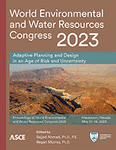Black-Box Modeling of Water Quality in WDS: A Case Study
Publication: World Environmental and Water Resources Congress 2023
ABSTRACT
Water quality is one of the most important factors in the design of water distribution systems (WDS). To maintain the conditions of water age, residual chlorine, and other quality characteristics, the ability to adjust hydraulic conditions using control elements is necessary. Although there are different methodologies for the analysis of water quality dynamics, the continued development and application of new modeling alternatives and methodologies to more efficiently represent water quality dynamics in WDS are needed to provide efficient tools for managing water quality in real time. The ability to provide water quality information in real-time would provide benefits under normal operating conditions and increase capabilities for fast responses in an unexpected pollution event, whether intentional or unintentional. Therefore, being able to use these new methodologies will enhance the capacity to develop and use adequate models to analyze different alternatives to quickly solve and control problems like the spread of a contaminant in a network. This study presents an initial analysis of water quality input-output data necessary for black-box modeling performed using the EPANET-MATLAB toolkit with respect to an existing WDS network, Bogotá, Colombia. The methodology is based on (1) analysis of model input and output variables, (2) numerical simulation of network water quality in the aforementioned software, and (3) data analytics comparing historical vs. simulated conditions for multiple scenarios. The purpose of this methodology is to estimate the sensitivity of existing models compared with new scenarios, created from different initial conditions for data analysis previous to the use of a black-box model.
Get full access to this article
View all available purchase options and get full access to this chapter.
REFERENCES
Abhijith, G. R., and Ostfeld, A. (2022). Contaminant Fate and Transport Modeling in Distribution Systems: EPANET-C. Water, 14(10), 1665. https://doi.org/10.3390/w14101665.
Boccelli, D. L., Tryby, M. E., Uber, J. G., and Summers, R. S. (2003). A reactive species model for chlorine decay and THM formation under rechlorination conditions. Water Research, 37(11), 2654–2666. https://doi.org/10.1016/S0043-1354(03)00067-8.
Dawood, T., Elwakil, E., Novoa, H. M., and Gárate Delgado, J. F. (2021). Toward urban sustainability and clean potable water: Prediction of water quality via artificial neural networks. Journal of Cleaner Production, 291. https://doi.org/10.1016/j.jclepro.2020.125266.
Eliades, D. G., Kyriakou, M., Vrachimis, S. G., and Polycarpou, M. M. (2016). EPANET-MATLAB Toolkit : An Open-Source Software for Interfacing EPANET with MATLAB. Computing and Control for the Water Industry CCWI 2016.
Elshorbagy, W. A. (2000). Kinetics of THM Species in Finished Drinking Water. Journal of Water Resources Planning and Management, 126(1), 21–28. https://doi.org/10.1061/(ASCE)0733-9496(2000)126:1(21).
E.A.A.B. (Empresa de Acueducto y Alcantarillado de Bogotá). (2018). Manual de operación del sistema matriz acueducto.
Enriquez, L., González, L., and Saldarriaga, J. (2022). Application of black-box models based on artificial intelligence for the prediction of chlorine and TTHMs in the trunk network of Bogotá, Colombia. 2nd International Joint Conference on Water Distribution Systems Analysis & Computing and Control in the Water Industry. https://doi.org/10.4995/WDSA-CCWI2022.2022.
Mao, R., Zhang, K., Zhang, Q., Xu, J., Cen, C., Pan, R., and Zhang, T. (2022). Joint majorization of waterworks and secondary chlorination points considering the chloric odor and economic investment in the DWDS using machine learning and optimization algorithms. Water Research, 220. https://doi.org/10.1016/j.watres.2022.118595.
Paçacı, G., Johnson, D., McKeever, S., and Hamfelt, A. (2019). Explaining black box models with inductive synthesis. Lecture Notes in Computer Science (Including Subseries Lecture Notes in Artificial Intelligence and Lecture Notes in Bioinformatics), 11540 LNCS, 334–345. https://doi.org/10.1007/978-3-030-22750-0_27.
Rossman, L. A., Clark, R. M., and Grayman, W. M. (1994). Modeling Chlorine Residuals in Drinking-Water Distribution Systems. Journal of Environmental Engineering, 120(4), 803–820. https://doi.org/10.1061/(ASCE)0733-9372(1994)120:4(803).
Vasconcelos, J., Rossman, L., Grayman, W., Boulos, P., and Clark, R. (1997). Kinetics of Chlorine Decay. Journal - American Water Works Association, 89, 54–65. https://doi.org/10.1002/j.1551-8833.1997.tb08259.x.
Information & Authors
Information
Published In
History
Published online: May 18, 2023
ASCE Technical Topics:
- Business management
- Case studies
- Data analysis
- Engineering fundamentals
- Environmental engineering
- Management methods
- Methodology (by type)
- Models (by type)
- Numerical models
- Practice and Profession
- Quality control
- Research methods (by type)
- Water and water resources
- Water conservation
- Water management
- Water policy
- Water quality
- Water supply
- Water supply systems
- Water treatment
Authors
Metrics & Citations
Metrics
Citations
Download citation
If you have the appropriate software installed, you can download article citation data to the citation manager of your choice. Simply select your manager software from the list below and click Download.
